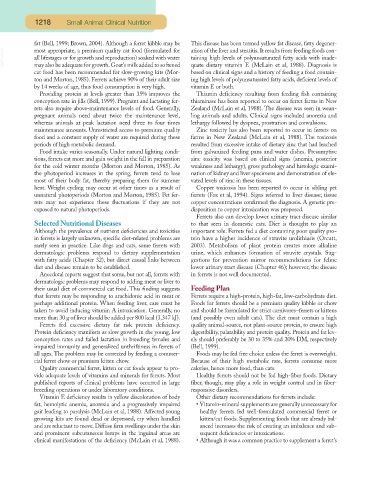Page 1168 - Small Animal Clinical Nutrition 5th Edition
P. 1168
1218 Small Animal Clinical Nutrition
fat (Bell, 1999; Brown, 2004). Although a ferret kibble may be This disease has been termed yellow fat disease, fatty degener-
VetBooks.ir most appropriate, a premium quality cat food (formulated for ation of the liver and steatitis. It results from feeding foods con-
taining high levels of polyunsaturated fatty acids with inade-
all lifestages or for growth and reproduction) soaked with water
may also be adequate for growth. Goat’s milk added to softened
quate dietary vitamin E (McLain et al, 1988). Diagnosis is
cat food has been recommended for slow-growing kits (Mor- based on clinical signs and a history of feeding a food contain-
ton and Morton, 1985). Ferrets achieve 90% of their adult size ing high levels of polyunsaturated fatty acids, deficient levels of
by 14 weeks of age, thus food consumption is very high. vitamin E or both.
Providing protein at levels greater than 35% improves the Thiamin deficiency resulting from feeding fish containing
conception rate in jills (Bell, 1999). Pregnant and lactating fer- thiaminase has been reported to occur on ferret farms in New
rets also require above-maintenance levels of food. Generally, Zealand (McLain et al, 1988). The disease was seen in wean-
pregnant animals need about twice the maintenance level, ling animals and adults. Clinical signs included anorexia and
whereas animals at peak lactation need three to four times lethargy followed by dyspnea, prostration and convulsions.
maintenance amounts. Unrestricted access to premium quality Zinc toxicity has also been reported to occur in ferrets on
food and a constant supply of water are required during these farms in New Zealand (McLain et al, 1988). The toxicosis
periods of high metabolic demand. resulted from excessive intake of dietary zinc that had leached
Food intake varies seasonally. Under natural lighting condi- from galvanized feeding pans and water dishes. Presumptive
tions, ferrets eat more and gain weight in the fall in preparation zinc toxicity was based on clinical signs (anemia, posterior
for the cold winter months (Morton and Morton, 1985). As weakness and lethargy), gross pathology and histologic exami-
the photoperiod increases in the spring, ferrets tend to lose nation of kidney and liver specimens and demonstration of ele-
most of their body fat, thereby preparing them for summer vated levels of zinc in these tissues.
heat. Weight cycling may occur at other times as a result of Copper toxicosis has been reported to occur in sibling pet
unnatural photoperiods (Morton and Morton, 1985). Pet fer- ferrets (Fox et al, 1994). Signs referred to liver disease; tissue
rets may not experience these fluctuations if they are not copper concentrations confirmed the diagnosis. A genetic pre-
exposed to natural photoperiods. disposition to copper intoxication was proposed.
Ferrets also can develop lower urinary tract disease similar
Selected Nutritional Diseases to that seen in domestic cats. Diet is thought to play an
Although the prevalence of nutrient deficiencies and toxicities important role. Ferrets fed a diet containing poor quality pro-
in ferrets is largely unknown, specific diet-related problems are tein have a higher incidence of struvite urolithiasis (Orcutt,
rarely seen in practice. Like dogs and cats, some ferrets with 2003). Metabolism of plant protein creates more alkaline
dermatologic problems respond to dietary supplementation urine, which enhances formation of struvite crystals. Sug-
with fatty acids (Chapter 32), but direct causal links between gestions for prevention mirror recommendations for feline
diet and disease remain to be established. lower urinary tract disease (Chapter 46); however, the disease
Anecdotal reports suggest that some, but not all, ferrets with in ferrets is not well documented.
dermatologic problems may respond to adding meat or liver to
their usual diet of commercial cat food. This finding suggests Feeding Plan
that ferrets may be responding to arachidonic acid in meat or Ferrets require a high-protein, high-fat, low-carbohydrate diet.
perhaps additional protein. When feeding liver, care must be Foods for ferrets should be a premium quality kibble or chow
taken to avoid inducing vitamin A intoxication. Generally, no and should be formulated for strict carnivores−ferrets or kittens
more than 30 g of liver should be added per 800 kcal (3,347 kJ). (and possibly even adult cats). The diet must contain a high
Ferrets fed excessive dietary fat risk protein deficiency. quality animal-source, not plant-source protein, to ensure high
Protein deficiency manifests as slow growth in the young, low digestibility, palatability and protein quality. Protein and fat lev-
conception rates and failed lactation in breeding females and els should preferably be 30 to 35% and 20% DM, respectively
impaired immunity and generalized unthriftiness in ferrets of (Bell, 1999).
all ages. The problem may be corrected by feeding a commer- Foods may be fed free choice unless the ferret is overweight.
cial ferret chow or premium kitten chow. Because of their high metabolic rate, ferrets consume more
Quality commercial ferret, kitten or cat foods appear to pro- calories, hence more food, than cats.
vide adequate levels of vitamins and minerals for ferrets. Most Healthy ferrets should not be fed high-fiber foods. Dietary
published reports of clinical problems have occurred in large fiber, though, may play a role in weight control and in fiber-
breeding operations or under laboratory conditions. responsive disorders.
Vitamin E deficiency results in yellow discoloration of body Other dietary recommendations for ferrets include:
fat, hemolytic anemia, anorexia and a progressively impaired • Vitamin-mineral supplements are generally unnecessary for
gait leading to paralysis (McLain et al, 1988). Affected young healthy ferrets fed well-formulated commercial ferret or
growing kits are found dead or depressed, cry when handled kitten/cat foods. Supplementing foods that are already bal-
and are reluctant to move. Diffuse firm swellings under the skin anced increases the risk of creating an imbalance and sub-
and prominent subcutaneous lumps in the inguinal areas are sequent deficiencies or intoxications.
clinical manifestations of the deficiency (McLain et al, 1988). • Although it was a common practice to supplement a ferret’s

